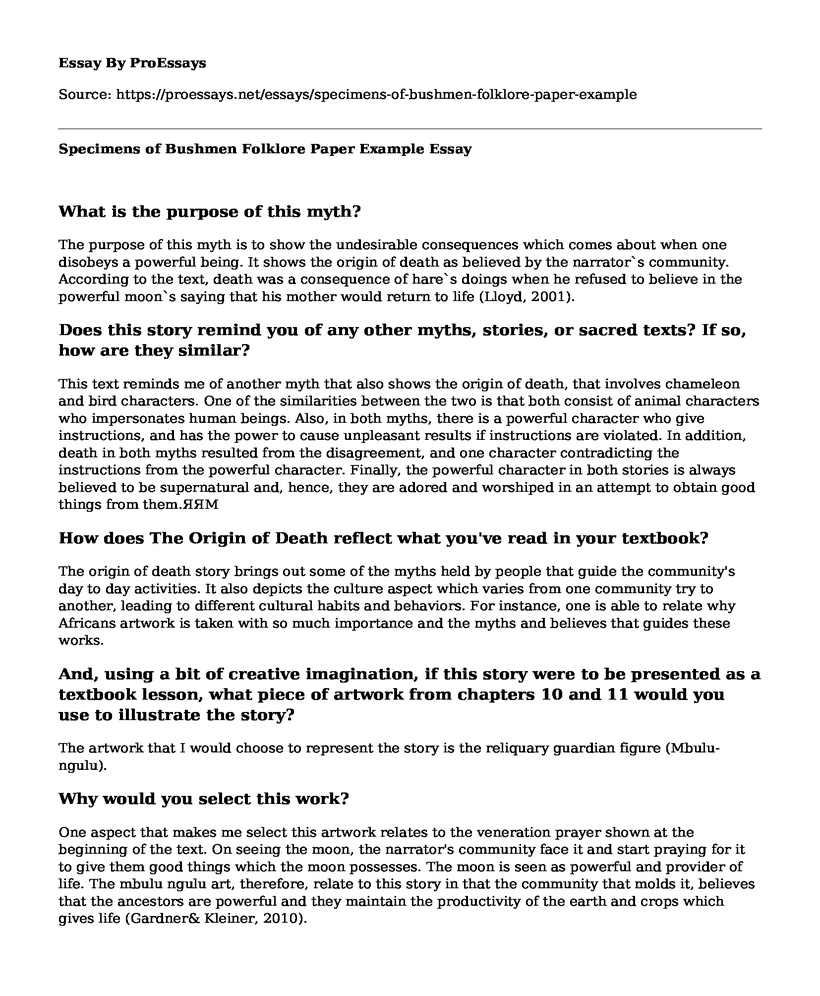What is the purpose of this myth?
The purpose of this myth is to show the undesirable consequences which comes about when one disobeys a powerful being. It shows the origin of death as believed by the narrator`s community. According to the text, death was a consequence of hare`s doings when he refused to believe in the powerful moon`s saying that his mother would return to life (Lloyd, 2001).
Does this story remind you of any other myths, stories, or sacred texts? If so, how are they similar?
This text reminds me of another myth that also shows the origin of death, that involves chameleon and bird characters. One of the similarities between the two is that both consist of animal characters who impersonates human beings. Also, in both myths, there is a powerful character who give instructions, and has the power to cause unpleasant results if instructions are violated. In addition, death in both myths resulted from the disagreement, and one character contradicting the instructions from the powerful character. Finally, the powerful character in both stories is always believed to be supernatural and, hence, they are adored and worshiped in an attempt to obtain good things from them.IaIaM
How does The Origin of Death reflect what you've read in your textbook?
The origin of death story brings out some of the myths held by people that guide the community's day to day activities. It also depicts the culture aspect which varies from one community try to another, leading to different cultural habits and behaviors. For instance, one is able to relate why Africans artwork is taken with so much importance and the myths and believes that guides these works.
And, using a bit of creative imagination, if this story were to be presented as a textbook lesson, what piece of artwork from chapters 10 and 11 would you use to illustrate the story?
The artwork that I would choose to represent the story is the reliquary guardian figure (Mbulu-ngulu).
Why would you select this work?
One aspect that makes me select this artwork relates to the veneration prayer shown at the beginning of the text. On seeing the moon, the narrator's community face it and start praying for it to give them good things which the moon possesses. The moon is seen as powerful and provider of life. The mbulu ngulu art, therefore, relate to this story in that the community that molds it, believes that the ancestors are powerful and they maintain the productivity of the earth and crops which gives life (Gardner& Kleiner, 2010).
Which literary figure do you connect the image from the text?
William Shakespeare is the literary figure that I connect with this artwork. He is adored and considered powerful because of his mastery in play rights which influenced most of modern literature.
Why was the man turned into a hare?
The man in the story had been turned by the supernatural moon into a hare which enabled communication between him and the moon. Afterwards when he contradicted the moon`s saying, he was cursed to be a hare all together because of his disobedience.
References
Gardner, H., & Kleiner, F. S. (2010). Gardner's art through the ages: Non-western perspectives. Boston: Wadsworth/Cengage Learning.
Lloyd, L. C. (2001). Specimens of bushmen folklore.
Cite this page
Specimens of Bushmen Folklore Paper Example. (2022, Sep 13). Retrieved from https://proessays.net/essays/specimens-of-bushmen-folklore-paper-example
If you are the original author of this essay and no longer wish to have it published on the ProEssays website, please click below to request its removal:
- The Hound of the Baskervilles by Sir Arthur Conan Doyle
- Culture Identity - Essay Example
- The Road Not Taken by Robert Frost Essay Example
- Native American Religion and Medicine
- Essay Sample on Freedom for All: Claiming Power and Overcoming Obstacles
- Essay Sample on The Color Purple: A Journey of Faith and Hope
- Essay Sample on Antigone: Sophocles' Classic Tragedy of Theban Legend







